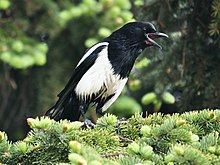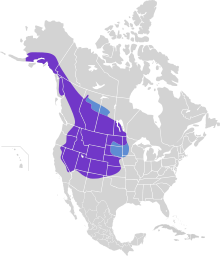| Black-billed magpie | |
|---|---|

| |
| In Flagstaff County, Alberta | |
| Black-billed magpie vocalizations | |
| Scientific classification | |
| Domain: | Eukaryota |
| Kingdom: | Animalia |
| Phylum: | Chordata |
| Class: | Aves |
| Order: | Passeriformes |
| Family: | Corvidae |
| Genus: | Pica |
| Species: | P. hudsonia
|
| Binomial name | |
| Pica hudsonia (Sabine, 1823)
| |

| |
Year-round range Winter range
| |
The black-billed magpie (Pica hudsonia), also known as the American magpie, is a bird in the corvid family found in the western half of North America. It is black and white, with the wings and tail showing black areas and iridescent hints of blue and blue-green. It was once thought to be a subspecies of Pica pica, which was known as the black-billed magpie at the time, but was placed into its own species in 2000 based on genetic studies. Currently, Pica pica is the scientific name of the Eurasian magpie.
This species prefers generally open habitats with clumps of trees, but can also commonly be found in farmlands and suburban areas. Historically associated with bison herds, it now lands on the backs of cattle to glean ticks and insects from them. Black-billed magpies commonly follow large predators, such as wolves, to scavenge from their kills. The species also walks or hops on the ground, where it obtains food items such as beetles, grasshoppers, worms, and small rodents.
The black-billed magpie builds domed nests which are made up of twigs and are located near the top of trees, usually housing six to seven eggs. Incubation, by the female only, starts when the clutch is complete, and lasts 16–21 days. The nestling period is three to four weeks. Black-billed magpies in the wild have a lifespan of six to seven years.
Black-billed magpies have a long history with humans, being featured in stories told by Indigenous tribes of the Great Plains. Where persecuted it becomes very wary, but otherwise it is fairly tolerant of human presence. Due to their perceived negative impact on cattle and game birds, black-billed magpies were hunted as a pest during the 1900s, and their population suffered as a result. Today, they are considered a species of least concern by the IUCN, and they are commonly seen throughout their range.
- ^ BirdLife International (2017) [amended version of 2016 assessment]. "Pica hudsonia". IUCN Red List of Threatened Species. 2017: e.T103727176A111465610. doi:10.2305/IUCN.UK.2017-1.RLTS.T103727176A111465610.en. Retrieved November 19, 2021.
